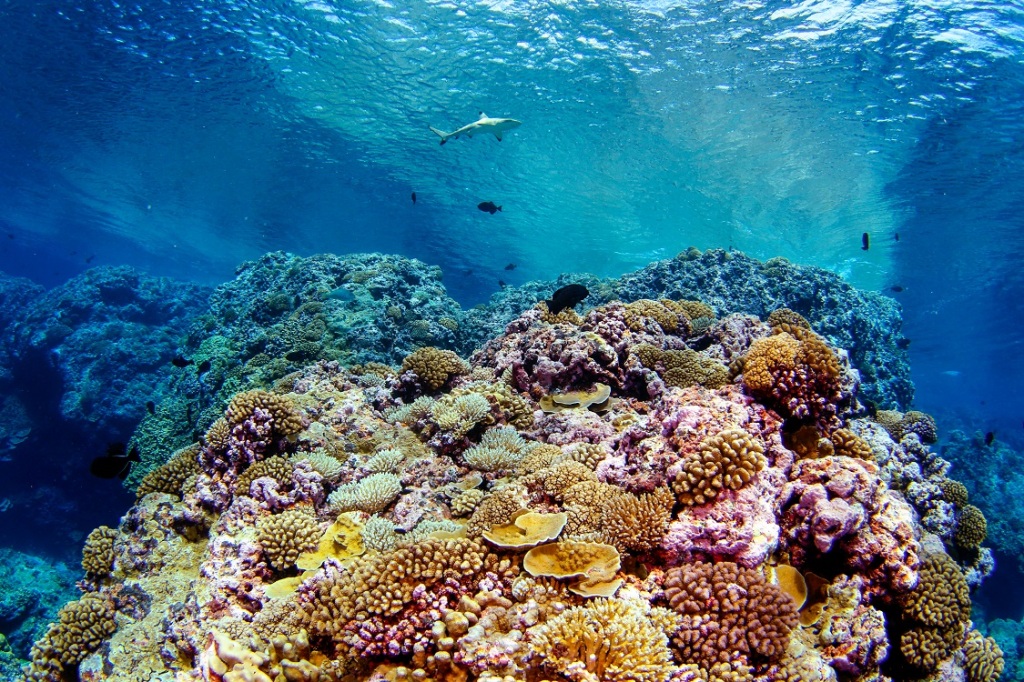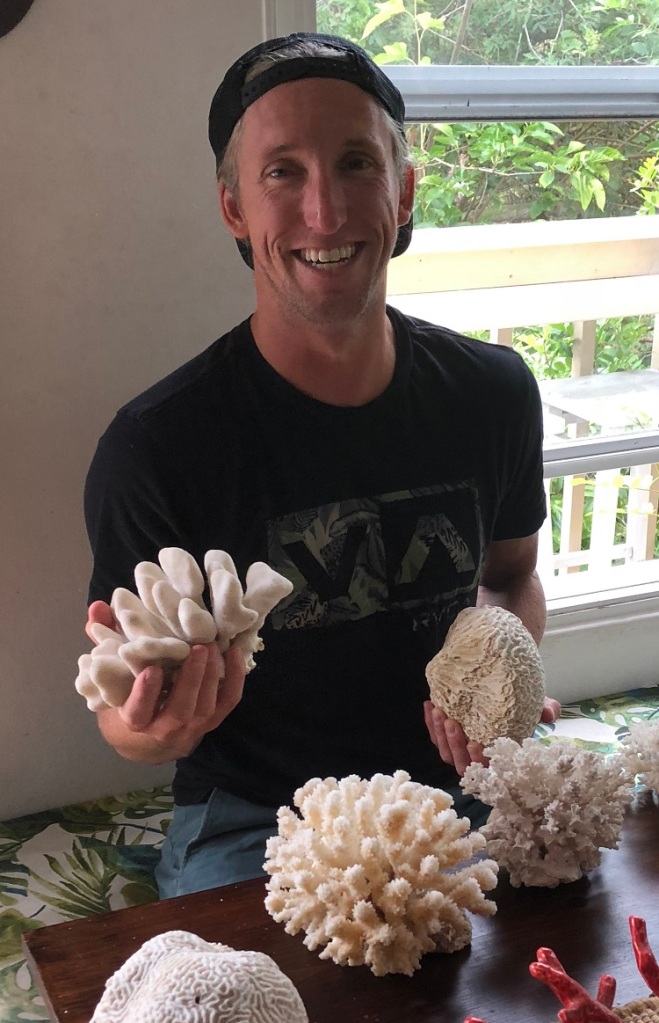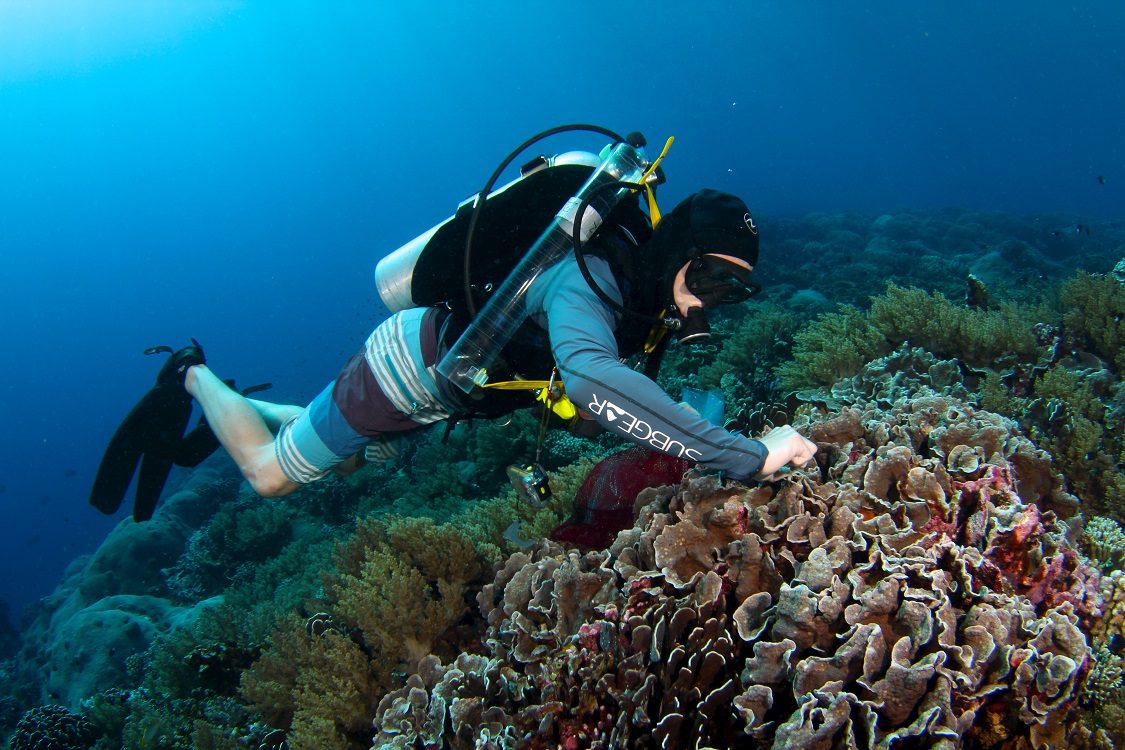Michael Fox is a postdoctoral scholar at Woods Hole Oceanographic Institution. His research interests revolve around the interactions between oceanography and coral reef ecology. He recently published a paper highlighting a new method for quantifying heterotrophic nutrition in reef-building corals, which revealed that coral diets might be more variable than we thought.
About the paper

What is the paper about?
Our paper is about developing a better way to understand where reef-building corals get their nutrition. Reef-building corals rely on their endosymbiotic microalgae for much of their energetic demands, but many are also voracious predators that can capture and consume a wide variety of prey. To date, this component of coral nutrition has largely been overlooked in field studies because it is difficult to measure. To address this knowledge gap, we applied an emerging analytical technique, d13C analysis of individual amino acids, to determine how important heterotrophic nutrition is for a common Indo-Pacific coral.
What is the background behind your paper?
Reef-building corals are often considered principally autotrophic because they receive a large proportion of their nutrition from symbiotic microalgae. In some coral species these algal cells can occur in densities of several million per square centimeter of coral tissue, so it is easy to see why we might assume that most corals don’t require additional sources of nutrition. However, based on what we know from laboratory studies, aquarists, and coral aquaculture it is widely accepted that heterotrophic nutrition has myriad physiological benefits to corals and that most corals love to eat. In the wild, the corals consume tiny prey making it difficult to visually estimate what (and how much) they are eating. To date, we have relied on bulk tissue stable isotopes (d13C and d15N) to examine coral diets, but this method only provides coarse estimates of what corals are eating and, thus, doesn’t provide much detail.
How did you come up with the idea for the paper?

For much of my PhD, I relied on bulk tissue stable isotope measurements to explore broad patterns of coral trophic ecology, but I was always looking for a technique that offered more quantitative precision. Around the same time, there was emerging research that used compound specific stable isotope analysis to explore trophic linkages in a level of detail not possible with traditional methods. I figured that this new technique had a lot of potential for unraveling auto- versus heterotrophic contributions to the diets of mixotrophic organisms like corals.
Fortunately, I knew just who could help me to test this theory. I contacted my friends and colleagues, Seth Newsome and Emma Elliott Smith, at the University of New Mexico and we devised a plan to study coral trophic ecology using d13C analysis of individual amino acids.
Does this article raise any new research questions?
Our findings raise a number of questions about the importance and universality of heterotrophy in reef-building corals, and we anticipate that the new technique we have developed will pave the way for future studies to reassess this important aspect of coral biology. One key question that arose from this study is why do colonies of the same species situated only a few meters apart have such different trophic strategies? We found that neighboring colonies could be primarily autotrophic or heavily reliant on heterotrophic nutrition. Understanding what drives this natural variation among individuals has important implications for coral population dynamics and our ability to predict how corals communities will respond to future environmental change.
About the research
What is the broader impact of your paper?

Rising ocean temperatures are threatening the persistence of coral reefs across the globe. As waters warm, the symbiosis between corals and their endosymbionts can breakdown, a process known as coral bleaching. When bleached, corals have lost their primary food source (autotrophic nutrition from their endosymbionts) and will ultimately starve to death if they are unable to regain their algal partners. Thus, corals that are better eaters or have more access to food may be more likely to survive and recover from bleaching. Our study provides a new tool to investigate the role of heterotrophy in the survival of coral reefs in a warming ocean. By better understanding how corals respond to patterns of food availability or how different species can modify their reliance on heterotrophy during bleaching we can improve our ability to predict where corals might be most likely to survive.
Where you surprised by anything when working on it?
One thing that really surprised us was how variable the trophic strategies of the different coral colonies were. We had expected that most individuals would share similar nutritional compositions with heterotrophy accounting for ~25% of their diet. However, we found that some individuals relied almost completely on autotrophy or heterotrophy.
What are the big questions still to answer?
There are a number of recent studies that have highlighted the importance of pelagic primary production in the functioning of coral reef ecosystems, particularly by providing key sources of energy and nutrients to corals and reef fishes. But our understanding of these linkages and what they mean for different organisms is still developing. Continuing to uncover the roles of pelagic or “off-reef” resources to corals is critical for understanding how future changes in primary production and ocean temperatures will impact the survival of coral reefs.
About the author
What is the best thing about being an ecologist?

One of my favorite things about being an ecologist is having the opportunity to explore remote locations, make natural history observations, and then ask scientific questions to understand those observations. Much of my research takes place on small, uninhabited islands across the Pacific and Indian Oceans. By studying reefs far from human populations we can better understand how these amazing systems function in their natural state. I am fortunate that my job allows me spend a lot time doing what I love – being on boats and spending many hours scuba diving. As an ecologist, these field experiences keep me inspired to ask questions and conduct research that will help us better understand and manage ocean ecosystems.
What’s your current position & what are you currently working on?
I am currently a Postdoctoral Scholar at Woods Hole Oceanographic Institution. My current research is building on the findings of this paper to explore broader spatial and taxonomic patterns of coral heterotrophy and to identify the physical mechanisms (e.g., currents and upwelling) that help deliver food to corals and promote their resilience to environmental change.
